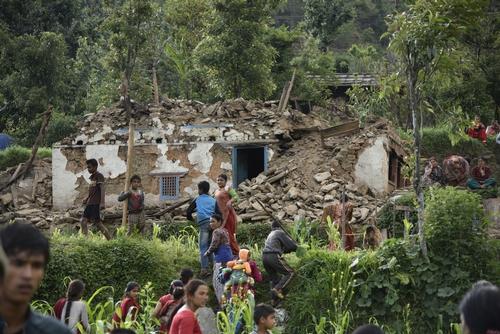Nepal has been hit by two earthquakes in less than three weeks, killing thousands, injuring tens of thousands, and leaving millions more with the burden of rebuilding their lives. Médecins Sans Frontières (MSF) teams, who were already on the ground soon after the first tremor, continue working to reach and assist people affected. The priority remains those spread across remote mountain villages who have borne the brunt of the earthquakes and remain isolated from help.
MSF teams mobilised shortly after the first 7.8 magnitude earthquake hit and began medical activities and distributing shelter and food by helicopter to people in isolated villages. Those teams were able to respond almost immediately following the second, 7.3 magnitude earthquake on 12 May. In remote villages, like Singati, Marbu, Yanglakot and Lapilang, MSF has evacuated patients in critical condition to hospitals in Kathmandu. The organisation is now conducting assessments following the second earthquake in order to adjust its assistance according to the needs that have arisen from the two quakes.
“In some areas, there has been up to 90% destruction,” said Dan Sermand, MSF’s Country Director in Nepal. “Hospitals, and health centres have been damaged by the two quakes leaving many people with no access even to the most basic healthcare. Up until yesterday, there were still landslides on-going in some mountainous areas that we assessed. In some areas, whole villages have now been brought down, compounding an already dire situation as many people had already lost their homes in the first earthquake.”
Healthcare
In many districts, hospitals and health centres have been flattened, and those still standing have numerous cracks making them susceptible to collapse. Bhaktapur hospital received a massive influx of wounded people after the second earthquake prompting MSF to donate dressing kits and medicine.
In Dhading, Gorkha, Rasuwa, Sindhupalchowk and Nuwakot districts, MSF is providing medical and psychological services to those in need, some of whom had not received any medical assistance since the first earthquake hit.
In Dolakha district, the epicentre of the second earthquake, MSF attended to people in critical conditions on the ground and evacuated those with severe injuries, including fractured skulls, to hospitals in Kathmandu for further medical attention.
In Arughat in Gorkha district, the MSF 20-bed inflatable hospital has been operational since 8th May and now sees patients affected by the two earthquakes as well as people from nearby communities. It has surgical capacity, maternity, emergency and general wards, and a mental health programme. MSF is additionally working with the Ministry of Health to offer outpatient services. MSF is also supporting drug supply, medical training and the referral system for the hospital. An average of 100 patients are treated per day in the outpatient department, mainly suffering from respiratory tract infections, diarrhoea, and wounds sustained from the earthquake. In the emergency room, MSF is treating an average of 15 patients per day mainly suffering from fractures and wounds. In maternity, the first baby was born this week on Tuesday
“Most of the health facilities in Gorkha district have collapsed and the Arughat hospital is helping provide the much-needed secondary healthcare in the area. There are people who tell us they have walked for 5 days to the Arughat hospital. This goes to show just how severely the earthquakes have destroyed the healthcare system,” said Dr Manangama Guyguy, Medical Coordinator in Nepal.
MSF has started providing mental health services and psychosocial sessions in villages in Nuwakot, Gorkha, Rusuwa and Sindhupalchowk districts. In the Arughat hospital MSF is also providing psychological care to patients and local staff who have been traumatised by the earthquake.

Shelter and Food
Aside from healthcare, shelter was already a major need before the second earthquake. The situation is now worse.
“My house was cracked in the first earthquake; the second earthquake finished it. I’m broken, I have lost my property and my cattle are no more, but I’m happy that my family was not in the house when this happened. They were in a displacement camp for fear of the house collapsing. And they were right,” said Rajkumar Pakhrin, MSF’s administration assistant from Mirge village in Dolakha District.
MSF teams have distributed over 2,300 shelter and hygiene kits in 20 of the most affected villages across Rasuwa, Sindupalchok and Gorkha districts. Teams have also begun distributing reconstruction material such as iron sheets and nails in some villages of Dhading, Sindhupalchowk and Rasuwa districts.
Food, mainly rice and high-energy biscuits, has been distributed in Rasuwa, Sindupalchok and Dhading districts.

Water and Sanitation
MSF has installed water supplies and is building latrines in Chuchibati camp in Kathmandu. Bladder tanks have also been set up in some villages in Rasuwa district. The team also provided the communities of Gumpatang, Tembatang and Nimlung of Sindhupalchowk district with pipes and tanks to restore their gravity water system.
Transport challenges
Air remains the only means of transport to reach mountainous areas where roads have been damaged or blocked. Since large helicopters cannot land in remote villages, where most of MSF’s work is concentrated, small helicopters are the only option. These have very limited flight-capacity, which restricts the amount of cargo that can be transported.
“In a few weeks the monsoon-season starts and people can no longer live outside,” said Peter Paul de Groote, MSF’s Emergency Coordinator in Nepal. “By then the remote areas will be very difficult to reach. The window of opportunity is now. We are making every effort to get shelter to these villages before this window closes.”
On 25 April 2015, a 7.8 magnitude earthquake struck Nepal with its epicentre in Gorkha district, 200 km northwest of the capital, Kathmandu. As of 11th May, the Government of Nepal reported 8,019 deaths and 17,866 injured people. On 12 May 2015 a new earthquake struck. The magnitude was 7.3, and the epicentre this time on the border of Dolakha and Sindhupalchowk, east of Kathmandu. At least 76 people were killed by this second earthquake and nearly 2,000 people injured.



